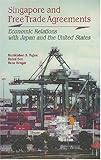Singapore and Free Trade Agreements : Economic Relations with Japan and the United States / Ramkishen S. Rajan, Rahul Sen, Reza Yamora Siregar.
Material type: TextPublisher: Singapore : ISEAS Publishing, [2001]Copyright date: ©2001Description: 1 online resource (116 p.)Content type:
TextPublisher: Singapore : ISEAS Publishing, [2001]Copyright date: ©2001Description: 1 online resource (116 p.)Content type: - 9789812301444
- 9789812305831
- 382.71095957 21
- HF2340.67 .R35 2001
- online - DeGruyter
| Item type | Current library | Call number | URL | Status | Notes | Barcode | |
|---|---|---|---|---|---|---|---|
 eBook
eBook
|
Biblioteca "Angelicum" Pont. Univ. S.Tommaso d'Aquino Nuvola online | online - DeGruyter (Browse shelf(Opens below)) | Online access | Not for loan (Accesso limitato) | Accesso per gli utenti autorizzati / Access for authorized users | (dgr)9789812305831 |
Browsing Biblioteca "Angelicum" Pont. Univ. S.Tommaso d'Aquino shelves, Shelving location: Nuvola online Close shelf browser (Hides shelf browser)

|

|

|

|

|

|

|
||
| online - DeGruyter Restoring East Asia's Dynamism / | online - DeGruyter Industrial Restructuring in East Asia : Towards the 21st Century / | online - DeGruyter East Timor : Development Challenges for the World's Newest Nation / | online - DeGruyter Singapore and Free Trade Agreements : Economic Relations with Japan and the United States / | online - DeGruyter Towards a Knowledge-based Economy : East Asia's Changing Industrial Geography / | online - DeGruyter Regional Economic Integration : Case for a Regional Export Credit Agency for Asia / | online - DeGruyter The Economics of the Enterprise for ASEAN Initiative / |
Frontmatter -- Contents -- List of Tables -- List of Figures -- About the Authors -- 1. INTRODUCTION -- 2. REASONS BEHIND SINGAPORE’S ATTRACTION TO FTAs -- 3. MERCHANDISE TRADE LINKAGES -- 4. IMPACT OF CHANGES IN FOREIGN DEMAND ON THE SINGAPORE ECONOMY -- 5. TRADE IN SERVICES AND DIRECT INVESTMENT -- 6. SINGAPORE AND THE NEW REGIONALISM: CAUTIONARY NOTES -- 7. CONCLUSION -- APPENDIX 1: TRADE INTENSITY INDICES -- APPENDIX 2: MEASURES OF INTRA-INDUSTRY TRADE (IIT) -- Notes -- References -- Index
restricted access online access with authorization star
http://purl.org/coar/access_right/c_16ec
As part of its trade policy, Singapore has recently embarked on what can broadly be termed "new regionalism". This is characterized by its new-found desire to enter into Free Trade Agreements (FTAs) with the economic powerhouses (Japan and the United States in particular) as well as with a number of other countries beyond the Southeast Asian region. What is behind this new trade policy and the seemingly sudden enthusiasm for such preferential trading arrangements? What, specifically, could Singapore be hoping to gain? Equally important, what are the potential risks and costs that the city-state’s policy-makers ought to consider in embarking on these Agreements? Beyond examining the motivation behind these trade moves, the authors also analyse the trade and investment linkages between Singapore and Japan and the United States in some detail.
Mode of access: Internet via World Wide Web.
In English.
Description based on online resource; title from PDF title page (publisher's Web site, viewed 01. Dez 2022)


